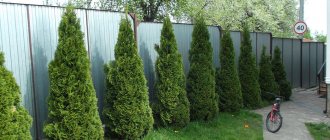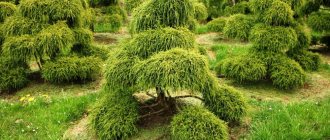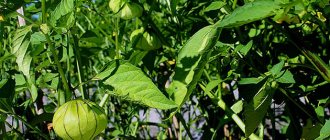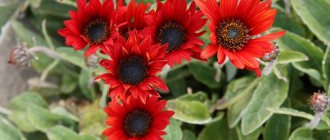Cypress trees were cultivated back in the eighteenth century. An evergreen, fragrant, frost-resistant plant that can take any form has become the best decoration of city parks and palace complexes. Over time, flower growers and breeders managed to domesticate the cypress tree and miniature coniferous shrubs settled in European homes.
Nowadays, charming Christmas trees are a favorite decoration for children's rooms, living rooms and even balconies. The plant perfectly deodorizes the air, purifies it and destroys fungi and bacteria. Cypress creates coziness and fills the room with the aroma of pine needles.
Description and features
received the name chamaecyparis cypress Later we became acquainted with wild cypress species. Among them there are erect trees up to 70 meters high. These cannot be called creeping or low. But the name has already taken root and entered the literature.
The Russian name cypress is also a diminutive. It immediately appears as a bush, not a tree. There are analogies, for example, rowan and fieldfare. The latter is a shrub. The hero of the article also has an English name - false cypress. Translation: false cypress. A non-expert may get confused. However, in fact, cypress is the middle ground between real cypress and thuja. This is an external impression.
The DNA of the cypress tree is closer to that of the thuja. Like her, the hero of the article has flat branches and leaves of two types. The first is scaly or facial. The second type of leaves is needle-shaped or lateral. If the plant is young, its foliage is needle-shaped. If the tree is mature, the greenery is scaly. During the transition period, both types of leaves are present.
Essentially, these are needles. It is not surprising that cypress is a coniferous plant. However, the branches and leaves of cypress are thinner than those of thuja. Therefore, the crowns of most species of the hero of the article are drooping. This is confirmed by the cypress tree in the photo.
The hero of the article got cones from the cypress tree. Their scales of the same size are arranged crosswise, in pairs. The cones are woody, located at the ends of the branches. The only difference is that it is smaller than that of cypress. Under each cone scale there are hidden from 2 to 5 seeds.
The valuable, white wood of the hero of the article also reminds us of the relationship with cypress. It is covered with bark, which changes depending on the age of the plant. The young have a reddish, thin, scaly cover. In adult cypress trees, the bark thickens and acquires a relief of furrows. The distinctive features of young cypress trees are called juvenile, that is, childlike.
Plants can transition to adulthood gradually, or abruptly, literally within a year. According to historical chronology, cypress is younger than thuja, which, together with thuja, became a separate genus approximately 110 million years ago.
This is the border of the Mesozoic and Cenozoic eras. It took another 10 million years for the cypress tree to split off. The hero of the article forms a single genus with Phociania. It is otherwise called Vietnamese cypress. Its cones have a diameter of about 1.2 centimeters. In cypress:
- the width of the fruit does not exceed 1 centimeter
- the seed is symmetrical, its 2 wings are absolutely identical, and not of different sizes, like those of Phokienia
- the stomatal veins are blurred and greenish, and in phokienia, clear, white stripes are visible on the back of the leaves
Cypress, thuja and phokienia are also distinguished by their smell. Young plant needles contain a lot of essential oils. You need to knead the leaves in your hands. In cypress trees it gives off an unpleasant odor. But not everyone catches it. In addition, the perception of aroma is individual. You might like the smell. The analysis is complicated by the abundance of hybrid species that combine representatives of different genera.
Medicinal properties
But the fact that a coniferous plant can purify the air in an apartment is a scientifically proven fact. Its presence will have a beneficial effect on the nervous and respiratory systems. The tree is capable of killing pathogenic microbes, which in our time of the coronavirus pandemic is especially important. Place a cypress tree at home, and there will be no need to use a sanitizer. After all, the green friend will disinfect the room on his own.
Types and varieties
There are 7 types of cypress trees. The first one is Taiwanese. Otherwise called Formosan. The species' natural habitat in Taiwan is under threat, largely due to the cypress tree itself. It is cut down for valuable timber. Trees of the species reach a height of 60 meters. The maximum trunk diameter is 7 meters.
Taiwanese cypress has green-brown needles. You can see it in the mountains. This is where the species grows. The minimum altitude above sea level is 1 thousand meters. The main thickets are located at almost 3 thousand. The following types of cypress also gravitate towards the mountains:
1. Japanese or pea cypress . It is never higher than 50 meters, and often 30-50 in height. The tree is distinguished by its crown in the shape of a cone or pin. It is composed of horizontally located, semi-hanging branches. The cones at their ends are spherical and the size of a pea. Hence the name of the species.
2. Obtuse cypress . It also grows in Japan, in its northern part. The height does not exceed 40 meters. The trunk width is 2 meters. It is distinguished by orange cones with a diameter of 1 centimeter. The crown of the tree is conical, but wide and dense with dark green needles.
In Russia, only 1 variety of the species is bred - cypress nana gracilis . It is short, up to 2.5 meters in height. Over the course of a year, the cypress gracilis gains a maximum of 7 centimeters. The result is a bush of irregular shape, but one that tolerates pruning well. This gives room for imagination in the formation of the gracilis crown.
3. Lawson cypress . It is distinguished by the bluish tint of its needles, cones and reddish bark. The height of the tree reaches 60 meters, but the diameter of the trunk is never wider than 2. The top of the tree droops down, as do the ends of the branches. This forms the crown in the shape of a narrow cone. Geographically, the species is native to North America.
4. Nutkan cypress . Otherwise called yellow. This is a tree up to 40 meters high with blue-green needles. Its belonging to the cypress tree is controversial, since there are differences from the rest. The yellow seeds do not have resin glands, the cones are larger than 1 centimeter, and there are no stomatal stripes on the needles. Russians can verify this in the arboretum of the Forestry Academy of St. Petersburg. In nature, the tree grows in the mountains along the Pacific coast of North America.
5. Funeral cypress . It has gray-green needles and a pronounced weeping crown with a small growth of 20 meters compared to other cypress trees. The tree's homeland is the mountains of China. The name of the species is associated with the use of wood. The mourning cypress tree, however, like the others, is almost impervious to rotting. Therefore, cypress wood has been used since ancient times for coffins and funeral urns.
The seventh species of cypress is the only one that does not climb mountains. This species is called arborvitae. It is the shortest, reaching 25 meters in natural conditions. The maximum trunk diameter is 1 meter. The needles of the plant are bluish. The crown of the thuja cypress is narrow and conical.
It is interesting that the name of the thuja cypress has nothing to do with the thuja. The name is related to the Greek word thyon. This is the name of one of the plants of the cypress family. It grows in the Mediterranean, where the Greeks saw it. The thuja cypress tree reminded them of this tree.
More than 200 varieties have been bred based on 7 species of cypress. More precisely, these varieties are obtained on the basis of 5 species. Mourning Formosan cypress trees are not grown in cultivation due to excessive whimsicality.
In Russia, the varieties of pea-bearing cypress are most often cultivated. Among them are winter-hardy:
- Cypress Boulevard. It owes its name to the Canadian nursery Boulevard, where it was bred in the 30s of the last century. The basis was the Scoarossa variety. The boulevard turned out to be lower, up to 2 meters high. This helps to overwinter in harsh climates.
The diameter of the pin-shaped crown of the boulevard exceeds a meter. There is a lot of greenery, it is thick. The needles are silver-blue in summer and purple in winter.
- Cypress filifera nana. It has a spherical, dense crown. The needles are green or blue-green, light green. The shade depends on the subspecies of the variety. The branches of the Nana cypress bend towards the ground. It gives the impression of a fountain of greenery.
Some varieties of the Lawson species also adapt to Russian conditions, for example, gray-blue aluminum, yellowish aluminum gold and light green erecta viridis. Blue cypress is also popular . It is fast growing. In 10 years, the tree stretches 3 meters, so it is important when forming high green hedges. They flaunt bright blue needles. Another advantage is winter hardiness with a mark of 6A. Most other varieties used in Russia have an indicator of 5A, that is, one less.
The blue variety has subspecies, for example, van pelts blue. It grows just as quickly, but is distinguished by steel-colored scales. The shape of the crown of the Pelts Blue baths is columnar. Among the cypress trees of the Lawson species, it is worth paying attention to:
- Stardust. Its cone is wide and quickly gains mass. By the age of 10, the tree stretches 2.5 meters. The maximum height in Russia is 10 meters. It is distinguished by golden needles.
- Yvonne. This variety has a pronounced drooping top. In this case, the branches of the tree grow almost vertically. The maximum height of the Yvonne cypress is 10 meters. But the tree needs bright sun. With its deficiency, the maximum height is 7 meters.
- Columnaris. The variety is of interest when planting trees in a row. Inexplicably, the plants are aligned in height and width of the crown. The result is a hedge of absolutely identical cypress trees. They are not demanding of light and are winter-hardy.
- Elwoodi cypress . This is the fruit of English breeders, bred at the beginning of the last century. It is small in size and slow growing. The dense crown of Elwoodi starts almost from the ground. The ends of the branches droop down.
Different varieties of cypress live from 300 to 1500 years. The period partly depends on the conditions and place of growth.
Nutkan
The international name in Latin is Chamaecyparis nootkatensis . Similar to Lawson's cypress; the main difference is the crown. At first it is narrow conical, later it becomes wide pyramid-shaped. The ascending shoots hang down at the ends. The bark is brownish-gray, cracks with age, and comes off in thin sheets. The needles are scale-like, sharp at the top. The species blooms in April. Female cones change color from brownish-red to brown with a bluish tinge and ripen the following year in May.
The ascending shoots hang down at the ends.
Varieties of Nootkan cypress:
- ‚Pendula‛;
- ‚Glauca‛;
- ‚Aypea‛;
- ‚Jubilee‛;
- ‚Lutea‛.
Chamaecyparis nootkatensis “Pendula” is a tree 10–15 m high with a straight trunk and weeping loose asymmetrical branches. At the age of 10 years it reaches 3 m, per year it increases by 15–25 cm. The Pendula cypress variety is undemanding to the soil, light-loving, and shade-tolerant. Requires abundant watering in summer and responds well to fertilizing with organic matter and complex mineral mixtures.
Glauca (Chamaecyparis nootkatensis "Glauca") is a tree 15–20 m high, reaching a maximum height of 40 m. The crown is neat, cone-shaped, expanding at the bottom to 5–7 m in diameter. The shoots are raised, the needles are hard, scaly, with a bluish tint. Glauka is undemanding about soil fertility, but prefers fairly moist areas. Young seedlings must be protected from wind and frost for the winter.
Where does cypress grow?
Cypress is originally of North American origin. The formation of the genus occurred 75 million years ago. Thus, the cypress tree is the oldest in the cypress family. Sixty million years ago the hero of the article moved to Asia. This is how two branches appeared - American and Asian.
Ideal for cypress trees are part of the islands of Britain, the lowlands of the Alps and Pyrenees, as well as the north-west of the Iberian Peninsula, the coast of the Black Sea and the Caucasus, the west of the Balkans, the south-east of China and the north of the Himalayas. That is, cypress needs elevated, humid, warm areas. The climate should be mild, monsoon or oceanic. That is, in general, the following are suitable for the hero of the article:
- All western Europe
- Eastern and northwestern United States
There are no harsh winters or summer droughts in these regions. In central Russia there is both. Therefore, growing cypress in our country means growing it in unsuitable areas. This complicates the process of caring for plants.
In terms of soil, the needs of cypress trees are more diverse than in terms of growing area. Although representatives of the genus love mountains, half of the species prefer poor soils, and the other half prefer rich ones.
However, in Russia it is recommended to plant all cypress trees in poor sandy-peaty soils. They slow down the growth of trees. This makes it easier to adapt to frost. When a tree on rich soil actively spends energy on growth, there is no more energy left for survival.
How and when to plant
Cypress planting is carried out using the vegetative method. Cultivars are not propagated by seeds, since species specimens do not survive in Russia. However, working with seeds makes sense when breeding domestic varieties. This is what breeders do. They plant seeds in the ground in the fall. This increases vigor and germination in the spring.
The seeds are placed 6 millimeters into the soil. In the spring, plantings are taken outside when frost is already excluded. It is not recommended to germinate seeds indoors, since the cypress tree then has difficulty adapting to outdoor conditions.
Seeds are placed outside in partial shade. The bright sun is destructive for seedlings. They appear slowly in Russian conditions. You need to be patient. The process progresses faster with cuttings. They home cypress as follows:
- cuttings 5-15 centimeters long are prepared in early spring
- place the cuttings in a mixture of equal parts of perlite and sand
- put to take root in a greenhouse with diffused light and maximum humidity
- after a month they check the presence of roots, and after 2 - their number
- with a good root system, the cuttings are left to overwinter in open ground
If Lawson cultivars are propagated, grafting is used. The point is the instability of plants of the species to late blight. This fungal disease is also called root rot. Therefore, lawson buds are transplanted onto cypress trees with calytropsis-type roots resistant to late blight. Another rootstock is the Platycladus variety.
Cypress trees, dug up with a clod of earth, are planted only in the spring! Plants in a container are placed in new soil from spring to mid-summer. In this case, the hole is prepared in the fall. Twenty centimeters at its bottom is drainage. This is broken brick plus coarse sand. Another half of the pit is a mixture of turf soil, peat, sand and humus. The latter requires 2 shares. One sand is required. Earth and peat are taken in 3 shares.
Before planting the cypress tree, the soil mixture is spilled. A plant is planted in the settled soil, filling the remaining space of the hole with a mixture of the same composition. Its mound should rise 10 centimeters above the surrounding ground, since over time it will settle to a level with it.
The planted cypress tree is watered abundantly and sprinkled with mulch around the trunk. This could be, for example, sawdust. Their layer will prevent rapid evaporation of moisture and retain soil heat. It is important to plant the cypress tree in a shaded, but not low-lying place. Cold air stagnates in the lowlands. It is heavier than the hot one rushing upward.
The degree of shading of the area is determined by the color of the cypress needles. If it is yellowish, light, it needs more sun. When planting several cypress trees, leave at least 0.8 meters between them. The root system of the hero of the article is actively developing in breadth.
Landing
Planted in places with partial shade, avoiding prolonged exposure to the sun and lowlands. The plant variety is taken into account. For example, species with yellow-green needles require more light. The soil is nutritious, always with drainage, without lime.
Green cypress
- The best landing time is April. The soil has warmed up and the likelihood of frost is low.
- Prepare a hole 90 centimeters deep, 50 cm wide. Crushed brick and sand are placed on the bottom. The thickness of the drainage is 20-30 cm. A substrate of turf, humus, peat, sand (3: 3: 2: 1) is poured on top. It is better to prepare the pit in the fall so that the substrate is rotted.
- When planting several plants, the recommended distance is at least 1 meter. More is better, because the root system grows horizontally.
- Before planting, water with rootstock. The seedling is placed in the center, fertile soil with nitroammophos is covered. Water, mulch and be sure to tie up.
Growing and care
Caring for cypress trees in Russia comes down to the use of low-growing forms that can be converted into elfin trees. The branches rushing upward are pinned to the ground. Then the plant spreads along it and overwinters well under the snow that warms it.
Medium- and tall-growing varieties of cypress are not recommended for Russia. Since low-growing varieties are used in our territories, the planting holes for them are small. A width of 70 centimeters and a depth of 60 are sufficient. When caring for the hero of the article, it is important to monitor soil moisture. It shouldn't dry out.
However, waterlogging is also not recommended, as it can lead to the development of late blight. If there is no rain, water the cypress tree at least once every 7 days. In hot weather, the number of waterings is doubled, pouring a bucket of water under the plant for each of them. This is the norm for an adult tree in Russian conditions.
Even in our conditions, the hero of the article needs sprinkling. Young bushes are sprayed daily, because in the humid native forests the everyday life of a cypress tree is exactly like this. Mature trees are sprayed at least 2 times a week. In this case, it is necessary to take into account the relationship between soil moisture and atmosphere.
They compensate each other. Therefore, cypress trees in shaded areas can be watered less. The air there is more humid. After watering the plant, loosen the soil around it by at least 6 centimeters. This is in the absence of mulch. If you want to speed up the growth of cypress, you can apply complex fertilizer. It is important to get there before mid-summer. Then growth will only harm the tree.
Secrets of success
The container for Cypress (if we are talking about growing indoors) is selected taking into account a fairly developed root system. It is best, especially for adult specimens, to buy clay pots. They are heavy, so they will not allow the plant to roll over under its own weight.
IN THE PHOTO: Cypress 'Teddy Bear' feels great in a clay pot.
Cypress loves well-drained, well-moistened soil. At the same time, you cannot flood it and turn the substrate into a swamp. But dry soil is also harmful for Cypress. As soon as the top layers of soil begin to dry out, you need to immediately start watering. The watering rate is 8–10 liters. water per plant. During drought, the amount and frequency of moistening the soil should be doubled.
If you need to replant Cypress, it is recommended to do this in the spring to minimize stress (at the same time, dry branches are sanitized). When replanting a bush, carefully examine its root system.
If the previous container was too cramped and some areas of the roots died, they must be removed. This will improve the health of Cypress and slightly restrain its growth, thereby ensuring the desired compactness.
When warm days arrive, Cypress leaves its dormant state and begins to develop more intensively. During this period, it is necessary to “support” it with a complex fertilizer (for example, mineral fertilizer “For conifers” containing humates). The fertilizer is applied diluted (according to the instructions) into the soil, which must first be loosened. Garden cypress trees are fed with complex fertilizer for conifers with a low NPK content in an amount of 100 to 150 g per m2. It is scattered near the tree trunks and embedded in the soil.
Cytovit, Zircon, Epin can be used as immunostimulants for Cypress.
Cypress transplant
The plant is replanted exclusively in the spring. It is important to take a bush with an earthen lump. This lump is wider than tall. Having replanted the bush, they estimate whether it will be completely covered with snowdrifts. If part of the crown risks remaining on the surface, it is covered using the standard method for conifers. The tree is wrapped in fabric (burlap) or covered with spruce branches.
You can attach them to a special cap. These are sold in gardening stores and nurseries. It is worth replanting cypress trees from a similar climate to a similar one. In other words, you should not bring the plant to Russia from Europe, even though the hero of the article costs a penny there, since it gains mass quickly and without problems.
The bush will be gorgeous the first summer, but it’s unlikely to survive until the second. Accordingly, it is advisable to purchase seedlings from Russian nurseries, and best of all, in your region or neighboring ones. Plants made from them will easily adapt to the local climate and soil.
Reproduction
New cypress plants are obtained in two ways:
- from seeds;
- from cuttings.
The rooting rate in the first case is much higher.
Seeds
After stratification, the seeds can be used for six months. After treating them with a growth stimulator, plant them in a not very deep container. In order for them to sprout, bottom heating and sufficient lighting should be provided. Sprouts should be cared for carefully.
Cuttings
Cuttings can be obtained from apical or lateral shoots. The branches should just begin to become woody. The cut is made 1.5 cm below the level of transition into green tissue. You can try to tear off the branch by grabbing the heel.
After treating the tips with root, plant them in the soil mixture, covering the top with an inverted glass jar.
Plant pruning
In the spring, the hero of the article easily tolerates pruning, both sanitary, when dead and weak parts are removed, and decorative. Using the latter, the bushes are formed into spirals, balls, and pins. The results are works of art, not bushes. These “play” on the general concept of the garden or park.
In Russian conditions, sanitary pruning is usually carried out. It is especially needed by tall cypress trees. After pruning, they become more winter-hardy. Without pruning, the bottom and top of the trees are exposed. This leads to loss of decorativeness.
Pruning cypress trees in Russian conditions is especially important, since cultivars are used in harsh conditions. Their juvenile (children's) stage is protracted. In wild species it is 1-3 years. In cultivars, childhood without leaf fall or branch fall sometimes lasts most of their life. That is why inside the crown there is always an abundance of yellowed but not fallen shoots. They must be removed manually.
Under natural conditions, cypress trees have not developed a mechanism for renewal and getting rid of excess during childhood, since the period for this is minimal. There is no need to shed branches and leaves during these 2 years. But, in unfavorable conditions and during cultivation, the juvenile period is prolonged, and the necessary mechanisms do not have time to develop.
Folk signs
Unfortunately, popular rumor is merciless towards the representative of the Kiparisov family. It is believed that this is a flower of death, which belongs exclusively in the cemetery. Well, if you put a flowerpot with conifers at home, it will attract the souls of the deceased into the home.
For an unmarried woman, the cypress tree seems to foretell loneliness. And if you put a flowerpot in the bedroom, it will negatively affect the mental activity of the owners.
Perhaps overly superstitious people will be imbued with such negative reviews and will not want to plant cypress in their home. But, believe me, this will not protect you from bad streaks in life, which happen to absolutely everyone without exception.
Possible diseases and methods of treating them
Some people mistake the appearance of brown, dead branches in the center of its crown for a cypress disease. Meanwhile, this is the norm. The shoots die off after living for 4-6 years. This phenomenon is called branch fall, by analogy with leaf fall. In return, new shoots appear. More precisely, they appear first, and then (in autumn) the old ones dry up.
Only flat trophic shoots die off in cypress trees. There are also side ones. They do not die off, but change. It is on them that the thin bark becomes thick and ribbed. The real diseases of the hero of the article include:
- Late blight. This, as already mentioned, is a fungal disease that develops under conditions of prolonged waterlogging of the soil. If this occurs, you need to treat the land with Ridomil Soil. It will serve as a preventive measure. If the rot has already developed, you will have to destroy the cypress tree along with an impressive lump of earth. Otherwise, the incurable disease will spread to neighboring plants. Sick people are burned. In their place, it is important not to plant crops susceptible to late blight for a long time.
- Spider mite. Caused by an arachnid. “Fitoverm” or “Vermitek” will help with it. These are ready-made formulations and are commercially available. It is easy to recognize a mite infestation by the web with which it envelops the plant. The arachnids themselves, 0.5 millimeters long, are visible from the back of the leaves.
- Shield. The disease is named after the insect that causes it. You can get rid of scale insects by treating the bushes with a soap solution. Of the ready-made products, “Nuprid” and related drugs help. The scale insects themselves can be recognized if plaques of sorts appear on the foliage. This is what the dense chitinous cover of insects looks like - protective shields.
If a bush is severely affected by any of the listed diseases, it is easier to destroy it than to cure it. A prolonged healing process can lead to infection of neighboring trees and plants.
First steps after purchase
When choosing a Cypress, pay close attention to the condition of its stems, green branches, needles and near-root zone. The crown should be an intense, rich shade (even if you liked the variety with yellow colored needles), without visible signs of disease, dry areas or damage.
IN THE PHOTO: Needles of a rich shade without dry areas are a sign of a healthy Cypress.
Dry tips of coniferous “legs”, small insects and white coating on the soil are a serious reason to refrain from purchasing a specimen.
A few weeks of rest are a prerequisite after purchasing Cypress. It should be protected from animals and children who can damage the crown or stems.
How to propagate
The reproduction of the hero of the article is based on tracking mutations. They are common among cypress trees and are divided into 2 groups:
- Somatic. They occur during growth on an initially standard bush. This is the result of spontaneous changes in somatic cells. Somatic changes affect part of the plant, forming, for example, a witch's broom. This is what they call a small tree on the main trunk. It is easy to develop dwarf varieties from such brooms. The grafting method helps.
- Generative. They are associated with changes in the primary germ cells, therefore they appear from the first minutes of the plant’s life.
All that remains is to look for valuable mutations in the plantings, fixing them and crossing them with each other if necessary. The abundance of mutations in cypress trees is proven by the case of plantings at the St. Petersburg Agricultural Academy. They brought wild Pisifera seeds there. Half of the seeds of this cypress tree produced predictable copies of the savage.
In the second half, various mutations were identified. The plants were different from the parent. Based on this, it is risky to propagate cypress by seeds if you want to get exact copies of the parent plant. It is better to use cuttings. How to harvest them is described above in the chapter “How and when to plant.”
The abundance of cypress mutations in different nurseries leads to confusion in identifying varieties. The same changes in genes can occur approximately simultaneously in different parts of the world. It is not always possible to find out about such cases in time. Therefore, the same mutagenic form is called differently in different parts and “released into the light.” As a result, the list of cypress cultivars contains almost 100 pages.
Preparing for winter
Before winter, cypress trees are watered abundantly. This prevents the plant from suffering from drought in the spring. The crown of the tree grows with warmth, but the soil is still frozen. She grabs the roots of a cypress tree. In natural conditions, it does not meet with this, it is not adapted to this. The tree has nowhere to get moisture for the crown that has begun to grow.
But where cypress trees are planted, the soil, as a rule, does not freeze to the full depth of the roots. Moisture poured into the soil in the fall will enter the system from the deep layer. In regions where the soil freezes to the entire depth of the cypress roots, it is especially important to mulch the soil generously in the fall. Requires 10 centimeters of sawdust and hay.
Mulch reduces the depth of soil freezing. It is also useful to shovel snow onto cypress trees. The branches of the bushes are flexible. Masses of snow are not able to break the shoots. But, only small cypress trees can be covered in this way. Also, do not forget about covering the plants with fabric. But this has already been written about in previous chapters.
Interesting Facts
All types of cypress are sexually compatible. Reproductive coincidence leads to the easy breeding of hybrid forms, sometimes spontaneously, that is, without directed human participation. In Russia, not a single type of cypress is grown in its pure form. Only cultivars are planted. They are usually classified according to decorative characteristics.
Species characteristics fade into the background. Many cultivars are so strikingly different from their ancestor species that it is almost impossible to establish relationships without DNA analysis. Considering the hunting for wild cypress wood, it is especially important to introduce them into cultivation. Perhaps this is the future of a plant that will “survive” from its normal habitat.
Glauka
The height of this cypress tree is 15-20 meters, the diameter of the narrow-conical crown is about 6 meters, the cracking bark is gray-brown in color, the needles are prickly, scaly, and bluish-green.
, mourning and Formosan , as well as their cultivars, are also grown in culture
Mourning cypress
Formosan cypress











